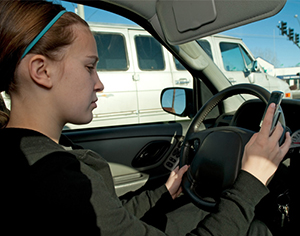Laws against texting while driving save lives

By Christina Sumners, Texas A&M School of Public Health
New evidence from the Texas A&M School of Public Health indicates that texting-while-driving laws may avert the need for emergency treatment following motor vehicle crashes. Researchers found that states with primary texting bans on all drivers saw, on average, an 8 percent reduction in emergency department visits resulting from motor vehicle crashes.
The research, led by Alva O. Ferdinand, DrPH, JD, assistant professor at the School of Public Health, was published today by the American Journal of Public Health.
A primary texting ban allows police officers to stop someone they see texting while driving. A secondary ban, on the other hand, only allows officers to cite someone for texting while driving if they pull that driver over for another reason, like speeding or running a red light.
Some of Ferdinand’s previous research showed that texting bans reduce the number of crash-related deaths and hospitalizations, but in this study, she wanted to determine whether they also reduce the number of minor injuries typically treated in emergency department settings.
“What I’m most interested in studying is whether laws — even ones we think of as punitive — benefit population health,” Ferdinand said.
 Ferdinand’s current research found that primary bans reduced crash-related emergency room visits in all age groups. “This is pretty convincing evidence that presence of the laws has some beneficial implications,” Ferdinand said.
Ferdinand’s current research found that primary bans reduced crash-related emergency room visits in all age groups. “This is pretty convincing evidence that presence of the laws has some beneficial implications,” Ferdinand said.
The researchers studied 16 states, comparing them to themselves and to Arizona, which served as the control state because it had no texting ban during the study period. They were also able to model how many crash-related emergency department visits were averted due to the bans while taking into account other factors that might affect crash rates, such as gasoline prices.
The findings indicated that states with primary bans on all drivers saw reductions in motor vehicle-related emergency department visits in all age groups. The average 8 percent reduction seen in states with a primary texting ban translates to 3,264 fewer visits per year. When looking at various age groups specifically, states with a primary texting ban saw, on average, 778 fewer visits among those 15–21 years old, 1,378 among those 22–33 years old, and 507 among those 34–45 years old each year following the implementation of the ban.
Ferdinand cautioned that because the research team only looked at 16 states, they can’t be sure the trends they saw would hold for the entire country. “We also can’t measure how well these laws are being enforced on the ground,” she said. “However, it’s exciting when research can demonstrate that the law can be a useful public health intervention.”
For more information about the Texas A&M School of Public Health visit: https://sph.tamhsc.edu/
To learn more about Texas A&M University visit: fearlessfront.com

